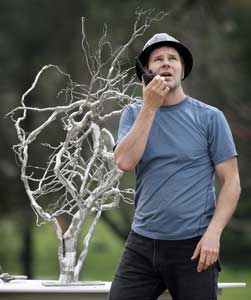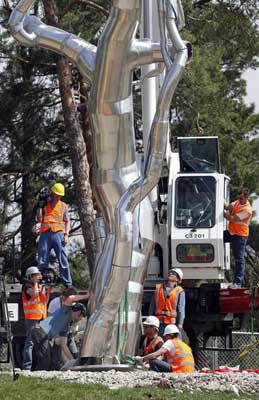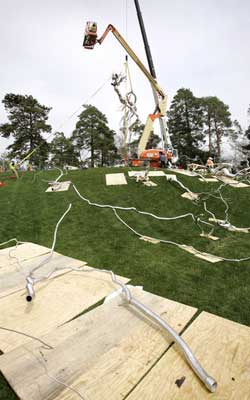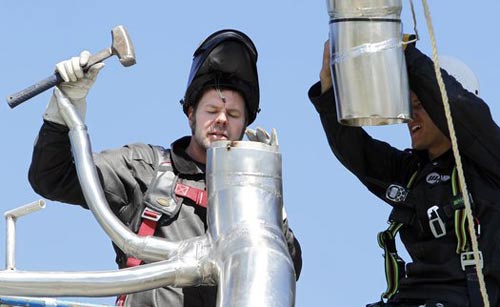
 Sculpture News at SculptSite.com
Sculpture News at SculptSite.com
Roxy Paine Sculpture |
|||
 A model of Paine's sculpture (above) sat behind the artist as he helped direct installation of the piece. Branches were laid out (left) on plywood sheets before being welded onto the sculpture. |
| The Kansas City Star | www.kansascity.com By ALICE THORSON Roxy Paine Sculpture at Kansas City Sculpture Park
|
 The trunk of artist Roxy Paine's metal tree sculpture "Ferment" was installed two Sundays ago in the Sculpture Park at the Nelson-Atkins Museum of Art. Installation work is completed, although landscaping work remains. The sculpture will be dedicated Friday. |
 Branches were scattered about as the main trunk of artist Roxy Paine's metal tree sculpture "Ferment" was installed on Sunday, April 10, 2011, in the Sculpture Park at the Nelson-Atkins Museum of Art. |
The Nelson commission came about when the Hall Family Foundation invited its long-time adviser, Martin Friedman, to choose a work for the park as his retirement gift. Friedman recently said he had been watching Paine's career and the evolution of the "Dendroids" for about 15 years. "The point is that they evolve," he said. "He's not doing the same thing over and over. He finds infinite possibilities in these branching forms." Paine's trees include an inverted version, shown in Europe in 2008 and recently installed at the Israel Museum in Jerusalem. He displayed a horizontal tree, "Maelstrom," on the roof of the Metropolitan Museum of Art in New York for six months in 2009. For the National Gallery of Canada he created "One Hundred Foot Line," a tree with no branches at all, and he exhibited a double-tree piece, called "Conjoined," in Madison Square Park in New York in 2007. Friedman thinks "Ferment" is "one of the best things (Paine) has ever done." "It draws energy from the earth and projects it," he said. "It crackles and animates the space around it. It's so energized, it gives off this agitation." Friedman sees references to human anatomy, hands and fingers in "Ferment." The branching forms also relate to human neuro-systems and blood circulation, he said. "It will be, metaphorically speaking, an energy core," he added. "The way it looks under changing light conditions, the reflections, the clouds passing overhead - it adds another dimension to the park." Friedman will come to town for the public dedication of "Ferment" on Friday, when he will discuss the piece with the museum director/CEO Julian Zugazagoitia as part of a "Ferment Event" in Atkins Auditorium. (See Page G1 for details.) The dedication will coincide with the opening of an exhibit in the Bloch Building lobby of Paine's "Scumaks and Dendroids." The exhibit, organized by Schall, features a sculpture-making machine or Scumak and models of "Ferment" and four other "Dendroid" sculptures. The Scumak, which harks to Paine's 2001 exhibit of a painting machine at Grand Arts contemporary art space here, is the fun part. During the four-month run of the exhibit, it will produce 42 maroon-colored blob forms, created from polyethylene beads and dye poured into a funnel at the top of the machine, heated to the melting point and then extruded. A computer determines the size and direction of the opening that releases the molten plastic, as well as how long - from 8 to 20 hours - the pour will last. Viewers can watch the Scumak at work, in a manner that resembles a frozen-custard machine The finished sculptures will be displayed on pedestals, and at the end of the show, the Nelson will keep three of them, Schall said. The exhibit's "Dendroid" models, scaled to a ratio of 1 inch equals 1 foot of the tow- ering sculptures, demonstrate the vastly differing personalities of Paine's tree works. They include models for "Ferment," "Conjoined" and the sinuous, tapering "One Hundred Foot Line." There is also a model for "Façade/Billboard," featuring a black silhouette of a tree framed by a steel armature. It is the second Paine tree acquired by the Wanas Foundation in Knislinge, Sweden, where Paine installed his first "Dendroid." The fifth model, titled "Distillation," is from Paine's recent show at James Cohan Gallery in New York. Light levels required that Paine's drawing for "Ferment" be displayed separately from the lobby exhibition. It will hang just outside Atkins Auditorium in the transitional space between the Nelson-Atkins building and the Bloch Building. On May 11, the museum will open an interactive component of the exhibit, titled "Creative Café," where visitors can build their own dendroids on computers installed in the Bloch Building café. Users will be able to print their images and post them to the Internet and the museum's website, Schall said. The program also includes a choice of park backdrops. |
 Captivating work these Dendroids by Roxy Paine. I find "Ferment" to be inspirational - you just don't forget it or any of the other Dencroids! One has to thank the Kansas City Sculpture Park at the Nelson-Atkins Museum of Art for recognizing the addition this makes to the Park and everyone who visits. We will endeavor to bring you some images of the finished installation. Here is a link to the Kansas City Sculpture Park at the Nelson-Atkins Museum of Art Dendroids forever!! |
 |
 |
More Sculpture News ....
Submit your SCULPTURE NEWS.
It's easy, just send us an e-mail
(click on Submit News in the left menu) with your pertinent information along with images, we'll take care of the rest. Sculpture makes our world a much better place in so many ways!
SculptSite.com, along with Sculptors and their creative genius all helping to bring the beauty and message of Sculpture to a hurried world.

